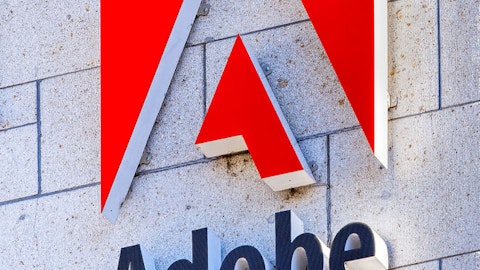Brian Wenzel : Yes. So as Brian mentioned earlier, not many will talk about it, but there is, what I would say, a more K-shape recovery or we’re seeing it, where the lower end consumer has been normalizing at a faster rate both, I’d say, from a payment rate behavior standpoint as well as a delinquency and charge-off standpoint. And as you continue to move away from the pandemic and stimulus, you begin to see the other cohorts, which is the prime and super prime, which had already started to normalize, continue to add normalization trends. I think the important part for us, Betsy, is as we take a step back and think about the entire portfolio for a second, if you looked at historical 30-plus and 90-plus-day delinquencies to pre-pandemic levels and applied it to our balances as you step through this year, what you’d see is a very linear normalization of delinquencies for us.
And again, that’s really the bottom end normalizing a little bit quicker. And now you’re starting to see the top end. So — but if you look at that linear pace beginning in the first quarter last year, I mean, we’re about 80% of our pre-pandemic delinquencies and it’s moved about 10 percentage points each quarter. So we’re not seeing an acceleration in normalization. It just kind of is flowing through and that’s on top of a larger balance, but it is normalizing in a manner in which we expected. But again, there is a little bit of a K-shaped recovery where we’re starting to feel — again, moving back, all our vintages from ’20 on are performing better than our vintages in 2018. So we feel good that the normalization that we’re expecting is happening on a path that we expect.
Betsy Graseck : Yes. And that was — part of the follow-up was around the vintages. So your vintages ’20, ’21, ’22, pretty similar. And I guess the underlying question here is, as the performance is coming in relative to what you had pre-pandemic, how much more room is there for opening up the credit box or pulling in incremental loan growth?
Brian Wenzel : Yes. I mean, if you break it apart for a second, Betsy, the ’20 vintage and obviously, the early part of 2021, that’s performing the best, right, because that’s when we put in refinements at start of the pandemic because no one knows what’s going to happen. Latter part of ’21 and ’22 performing between that vintage and 2018. So I think, in all cases, they’re doing better, but again, they’re slightly different under different underwriting standards. I don’t envision, and Brian talked about this, the consistency that we have both in underwriting for origination, but account management that we’re going to use that as a growth lever. I think we have a really diverse and attractive set of partners, so we get spend across a multitude of different verticals and categories.
And then when you look at the fact that we’re really having — have compelling value propositions and are aligning to our most loyal customers at our partners, we don’t have to use credit or growth engine as opposed to others. So I don’t envision us using credit and opening up the credit box from here forward. Right now, what we’re doing is we’re making modest refinements when we see things that concern us, but we’re not doing anything across the board because we don’t see it across the board in our portfolio.
Operator: We’ll take our next question from Kevin Barker with Piper Sandler.
Kevin Barker : I just wanted to follow up on some of the capital questions. If we did see a rapid increase in unemployment from a base rate of 3.5% to roughly 5% or maybe somewhere around that level as we approach year-end ’23, I mean would you start to consider your capital levels to have already embedded that type of unemployment rate or those types of assumptions of economic deterioration just given the stress test? Or do you feel like you need to be a little bit more cautious given the outlook could change rapidly in that type of environment?
Brian Wenzel : Yes. So first of all, thanks for the question, Kevin. When we think about our capital plan and the stress test we run, the unemployment rates that we use in those stress tests are significantly higher than 5%. So the 5% isn’t concerning on its face value relative to capital and our capital levels. What really we would look at and our risk committee and the Board would look at is, is there a reduced visibility into the macroeconomic environment where you’re concerned, or in the case — or in the case where you’re concerned about the level of net income being generated. That’s where you would come back to saying, “Hey, listen, should I think about capital differently?” But remember, these stress test models are built under a very severe scenario.
And as long as you’re inside of that, you should be able to — you continue on your capital plans and be able to weather it. That’s why it is. There’s a lot of buffers on top of the minimum requirements. So again, it’d be well north of 5% before we get concerned.
Kevin Barker : Okay. And then in regards to — maybe a follow-up to that on M&A. I think you’ve mentioned that the valuations are finally normalizing. Are you seeing any attractive opportunities start to develop, whether it’s portfolios or other acquisition potential targets given what we see out there today?
Brian Doubles : Yes. Look, I think you’re right. I mean we’re finally seeing valuations check up pretty significantly in some areas that we’re interested in. Our business development team has a very active M&A screen, so that’s certainly something that we look at. You’ve seen us do small acquisitions where we can kind of leverage our scale, Allegro is a great example of that, pets Best is a great example of that, and we’ve grown those businesses very significantly since we acquired them. But we’re a very disciplined buyer as well. Those were very modest in terms of the capital outlay, but we saw a lot of future growth and earnings potential. Those are the things that we like to do. And so if we can do more acquisitions like that, we’d certainly look to do that, but we’re a very disciplined buyer when it comes to allocating capital to M&A.
Operator: We’ll take our next question from John Hecht with Jefferies.
John Hecht : I guess first one is just on the NIM. You talked about deposit durations changing and so forth. Maybe can you just detail to us, is the shift in deposit prices mostly over what your outlook is there? And any characteristic of kind of the duration of deposits now versus where it has been?
Brian Wenzel : Yes, thanks for the question, John. So I will deal with the latter part of the question first. So yes, we have seen an extension of the duration a little bit. People have rotated into CDs and we see people into, call it, that 18 month, 19 month duration. So it’s split out a little bit, I wouldn’t say materially. With regard to pricing as we move forward, I mean obviously when we gave the NIM guidance here, what we saw in 2022 was really a change in the landscape, right? You had a lot of people trying to manage betas in the beginning part of 2022 and then when they fell at the outflow of deposits during the year, got more aggressive with regard to price. I think you saw a lot of that happen in the latter part of the year.
It’s been very stable now. So our outlook includes deposit betas getting a little bit worse than they have been from here, particularly on the CDs. So again, this is going to be something that we’re really going to watch relative to the Fed’s actions at the next couple of meetings and what their guidance is with regard to the terminal rate that they have out there. But we plan for in this guidance to have betas deteriorate in 2023.
John Hecht : Okay. That’s helpful. And then a second question, maybe can you characterize — you have some traditional partners, traditional retail partners like Lowe’s and so forth and then digital platforms like Amazon and PayPal. Is there anything worth noting about the general trends in the different types of platforms and how that might manifest itself over the course of ’23?
Brian Doubles : Yes. Well, so obviously, we serve a very broad range of partners, as you indicated. And clearly, you saw really strong growth in Digital, strong growth in Health & Wellness. We would expect that to continue. I’ll tell you where you see the biggest differences, John, is actually in how we engage with those partners. And our solutions inside of those partners differ quite a bit. Venmo and PayPal is a great example where we’re completely integrated through our API architecture. And if you’re inside of the PayPal or Venmo app, you don’t know if it’s something that we built or something that PayPal built. It is really seamless to the customer. And that’s really important. And I think that really helps make that experience a good one for the customer and helps us drive growth over the long term.
And you compare and contrast that with what we’re trying to do in the one-to-many space like with Clover and other solutions where we want to make it really easy for our smaller partners to leverage the financial products that we have, and we have to do that by building it once and then scaling it across the enterprise. So you really run the gamut from highly customized, fully integrated API architecture to a one-to-many solution, which just makes it really easy for our partners to offer our financing products. So that’s where you see the biggest difference between our partners and the partner set that we have today. I’ll tell you, at any given time, you’re going to have some partners that are doing really well and just crushing it, and you’re going to have some partners that are maybe struggling a little bit.
As I said earlier, heading into uncertain times like this, the credit program becomes even more important, and that’s consistent across the board. So heading into an environment like this, we feel like we’re really well positioned to help our partners succeed.





